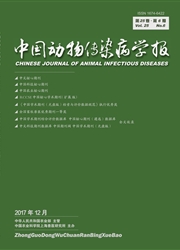

 中文摘要:
中文摘要:
为了解近年来云南省师宗县蓝舌病病毒流行情况,2012年在师宗县五龙乡建立了10头蓝舌病血清学阴性黄牛的监控动物群。从2012年5-10月,每周采血1次,11-12月,每月采血1次,采用C-ELISA进行血清学监测。8月开始动物血清学检测结果转阳性,至11月,监控动物全部转为阳性。用转阳前1周、转阳本周、转阳后2-13周的经处理的红细胞静脉接种鸡胚,收获鸡胚肝脏,用PBS悬浮捣碎的鸡胚肝脏,上清接种于C6/36细胞一代、BHK-21三代后,出现细胞病变(cytopathic effect, CPE)。采用RT-PCR方法,针对蓝舌病较为保守的血清型群特异片段VP7设计了2对引物,扩增其相应片段。结果显示,共分离到86份疑似分离物,其中67份疑似分离物细胞培养液上清经RT-PCR扩增,均扩增出1156 bp片段,初步确认为蓝舌病病毒。采用国际24个蓝舌病标准毒及24个标准阳性血清对86份疑似分离物及其对应血清进行细胞微量中和试验,67份毒株为蓝舌病病毒,与RT-PCR结果一致。通过对2份经中和试验定型为BTV-1、BTV-16分离株的VP2基因测序分析发现,BTV-1株序列与同型Y863(登录号:KC879616)参考毒株的同源性为92%,BTV-16株序列与登录号为AB686221的毒株同源性为99%。结果表明共分离到67株蓝舌病毒株,分离株主要为BTV-1、BTV-9、BTV-16三个血清型。
 英文摘要:
英文摘要:
The sentinel herd of 10 cattle was established in 2012 to monitor epidemiology of Bluetongue virus in Shizong county of Yunnan Province. Blood samples were taken weekly from May to October and then monthly from November to December 2014 and tested for serological response in C-ELISA and for virus isolation. The sero-conversion was revealed in August in some animals and then in November in whole sentinel herd. The erythrocyte preparations from blood samples were inoculated into chicken embryo veins. Chicken liver tissues were harvested, homogenized in PBS and centrifuged. The supernatants were inoculated into C6/36 cells and passaged in BHK-21 three times. The cytopathic effect (CPE) was observed in cell monolayers. The resulting 86 virus isolates were characterized in RT-PCR and virus neutralization (VN). The VP7 gene of Bluetongue virus was amplified in conventional RT-PCR using two pairs of primers designed according to the sequences in GenBank. A 1156 bp fragment of VP7 gene was amplified in RT-PCR from 67 out of 86 isolates. The virus neutralization was performed using 24 reference bluetongue viruses and 24 positive sera. Again, the same 67 isolates were confirmed as Bluetongue virus. The VP2 gene of two isolates was sequenced. One isolate was determined to be BTV-1 as it shared 92%identity with the reference strain Y863 (KC879616) and another isolate was BTV-16 as it shared 99%identity with the reference strain AB686221. The VN results also had an agreement with VP2 sequencing. In conclusion, 67 isolates isolated from the sentinel herd belonged to Bluetongue virus, indicating the virus transmission among bovine herds.
 同期刊论文项目
同期刊论文项目
 同项目期刊论文
同项目期刊论文
 期刊信息
期刊信息
